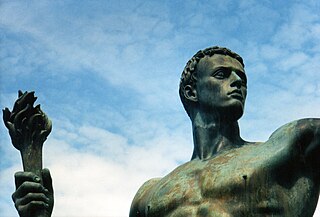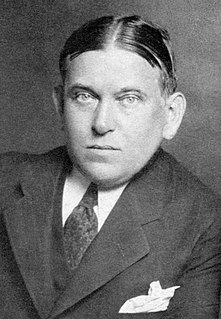
Transhumanism is an international philosophical movement that advocates for the transformation of the human condition by developing and making widely available sophisticated technologies to greatly enhance human intellect and physiology.

David Pearce is co-founder of the World Transhumanist Association, currently rebranded and incorporated as Humanity+, Inc., and a prominent figure within the transhumanism movement.
In competitive sports, doping is the use of banned athletic performance-enhancing drugs by athletic competitors. The term doping is widely used by organizations that regulate sporting competitions. The use of drugs to enhance performance is considered unethical, and therefore prohibited, by most international sports organizations, including the International Olympic Committee. Furthermore, athletes taking explicit measures to evade detection exacerbates the ethical violation with overt deception and cheating.
A super race is a future race of improved humans that it is proposed be created from present-day human beings by deploying various means such as eugenics, euthenics, genetic engineering, nanotechnology, and/or brain-computer interfacing to accelerate the process of human evolution.

The supersoldier is a concept soldier, often fictional, capable of operating beyond normal human limits or abilities.
Human enhancement (HE) can be described as the natural, artificial, or technological alteration of the human body in order to enhance physical or mental capabilities.

Superhuman strength is an ability commonly invoked in fiction and other literary works such as mythology. It is the power to exert force and lift weights beyond what is physically possible for a human. It is a fictionalized representation of the phenomenon of hysterical strength. Alternate pronunciations or descriptions of superhuman strength have included enhanced strength, super-strength, and increased strength. Superhuman strength is an amorphous ability, varying in potency depending on the writer or the context of the story in which it is depicted.

Friedrich Nietzsche developed his philosophy during the late 19th century. He owed the awakening of his philosophical interest to reading Arthur Schopenhauer's Die Welt als Wille und Vorstellung and said that Schopenhauer was one of the few thinkers that he respected, dedicating to him his essay Schopenhauer als Erzieher, published in 1874 as one of his Untimely Meditations.

The following outline provides an overview of and a topical guide to transhumanism, an international intellectual and cultural movement that affirms the possibility and desirability of fundamentally transforming the human condition by developing and making widely available technologies to eliminate aging and to greatly enhance human intellectual, physical and psychological capacities. Transhumanist thinkers study the potential benefits and dangers of emerging and hypothetical technologies that could overcome fundamental human limitations as well as study the ethical matters involved in developing and using such technologies. They predict that human beings may eventually be able to transform themselves into beings with such greatly expanded abilities as to merit the label posthuman.
Performance-enhancing substances, also known as performance-enhancing drugs (PED), are substances that are used to improve any form of activity performance in humans. A well-known example involves doping in sport, where banned physical performance–enhancing drugs are used by athletes and bodybuilders. Athletic performance-enhancing substances are sometimes referred to as ergogenic aids. Cognitive performance-enhancing drugs, commonly called nootropics, are sometimes used by students to improve academic performance. Performance-enhancing substances are also used by military personnel to enhance combat performance.
Posthuman or post-human is a concept originating in the fields of science fiction, futurology, contemporary art, and philosophy that literally means a person or entity that exists in a state beyond being human. The concept addresses questions of ethics and justice, language and trans-species communication, social systems, and the intellectual aspirations of interdisciplinarity.
The use of anabolic steroids and performance-enhancing drugs in American football is officially prohibited by virtually every sanctioning body.

Anabolic steroids, also known more properly as anabolic–androgenic steroids (AAS), are steroidal androgens that include natural androgens like testosterone as well as synthetic androgens that are structurally related and have similar effects to testosterone. They are anabolic and increase protein within cells, especially in skeletal muscles, and also have varying degrees of androgenic and virilizing effects, including induction of the development and maintenance of masculine secondary sexual characteristics such as the growth of facial and body hair. The word anabolic, referring to anabolism, comes from the Greek ἀναβολή anabole, "that which is thrown up, mound". Androgens or AAS are one of three types of sex hormone agonists, the others being estrogens like estradiol and progestogens like progesterone.
Growth hormone in sports are one of the few legal steroids in 2018. It refers to the use of growth hormones for athletic enhancement, as opposed to growth hormone treatment for medical therapy. Human Growth Hormone is a prescription medication, meaning that its distribution and use without a prescription is illegal. There is limited evidence that GH doping improves athletic performance, although the perception that it does is common in the sporting community. Potential side effects of long term GH doping could mirror the symptoms found in sufferers of acromegaly, a disease in which the anterior pituitary gland produces excess growth hormone.
A superhuman is an entity with intelligence or abilities exceeding normal human standards.
The New Man is a utopian concept that involves the creation of a new ideal human being or citizen replacing un-ideal human beings or citizens. The meaning of a New Man has widely varied and various alternatives have been suggested by a variety of religions and political ideologies, including Christianity, communism, classical liberalism, fascism, and utopian socialism.

Transhumanist politics constitutes a group of political ideologies that generally express the belief in improving human individuals through science and technology.
Gobinism, also known as Gobineauism, was an academic, political and social movement formed in 19th-century Germany based on the works of French aristocrat Arthur de Gobineau. An ethnically pro-Germanic while anti-national ideology, particularly against the French nation; the movement had influenced German nationalists and intellectuals such as Richard Wagner and Friedrich Nietzsche. Historians have described Gobinism as becoming cult-like by the end of the nineteenth century, with powerful and influential followers, specifically in the Pan-Germanism movement.














